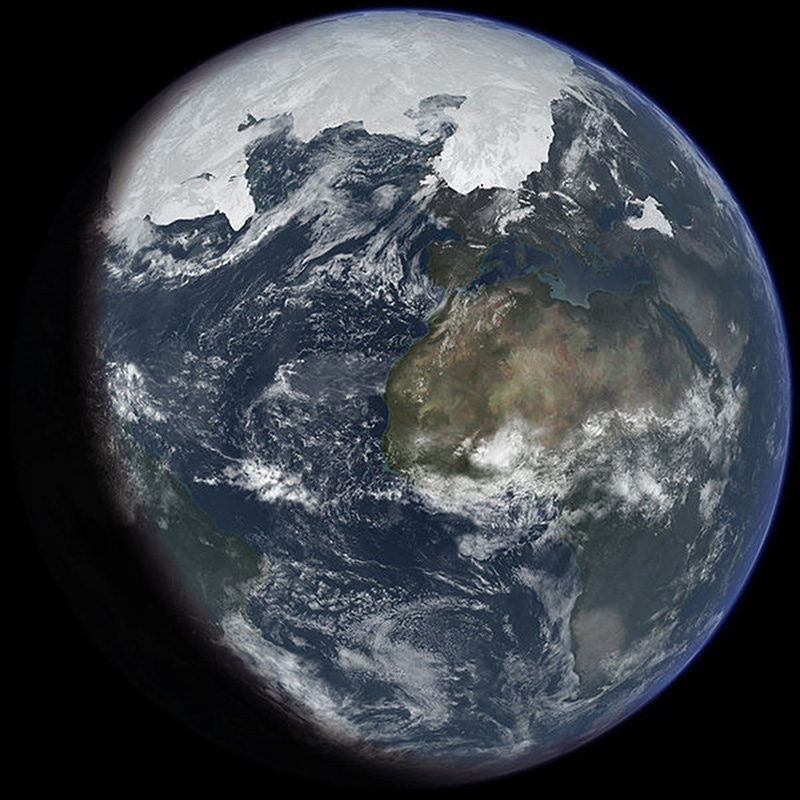
For the majority of Earth’s history, the planet has been hotter than today.
Hotter periods make up some 70 percent of the past two and a half billion years, and are called Greenhouse Earth. They can last hundreds of millions of years, with CO2 levels 10–20 times higher than today, and no ice anywhere on the planet.
During a Greenhouse interval, Earth actually explodes with life.
The age of dinosaurs happened during a Greenhouse. Land animals covered the continents. Reptiles swam in Arctic seas. Birds, mammals and flowering plants first appeared.
It’s been colder the other 30 percent of the past two and a half billion years, called Icehouse Earth. Life struggles in the most severe of these times.
Within Icehouse periods, Earth has shorter cycles of glacials and interglacials.
Glacial periods last about 80,000 years, when ice sheets cover large parts of the continents. Interglacials last for 20,000 years or less, and ice retreats toward the poles.
We’re living in a mild interglacial of a long-term Icehouse now. Temperate climate for many millennia has allowed the human population to expand to what it is today.
Human activity may be accelerating warming, but historical climate patterns suggest that within a few thousand years we could enter another glacial period, when ice would slowly advance again from the poles.
Why we shift from Icehouse to Greenhouse, and glacial to interglacial, are important concepts, which we’ll explore on another EarthDate.
Background
Synopsis: For at least 2.5 billion years, since the beginning of the Proterozoic Eon, Earth’s climate has fluctuated between icehouse and greenhouse conditions. Over this period, five great ice ages have occurred, with durations ranging from about 30 to 215 million years. For the rest of the period—more than 70 percent of its history—Earth appears to have been in a greenhouse state: largely ice free, even at the poles.
- Greenhouse Earth is characterized by a lack of continental ice sheets; high levels of carbon dioxide, water, and methane; and sea-surface temperatures that range from 28°C (82.4°F) in the tropics to 0°C (32°F) at the poles.
- The Cambrian explosion of life (~540 million years ago) occurred during a Greenhouse Earth state.
- Dinosaurs evolved and thrived during the Mesozoic Greenhouse Earth period (~250–66 million years ago), from the hot red deserts of the Triassic to the lush tropical jungles that dominated the planet in the Jurassic and Cretaceous.
- Icehouse Earth occurs when there is a long-term decrease in temperatures on Earth’s surface and atmosphere, leading to polar ice caps and continental ice sheets. Five significant Icehouse Earth periods have been recorded in the past 2.5 billion years:
- The Huronian Ice Age lasted about 200 million years in the early Proterozoic Eon, from 2.4 to 2.2 billion years ago, causing the first of several “Snowball Earth” phases when Earth’s surface became entirely frozen.
- The Cryogenian Ice Age lasted about 215 million years during the Neoproterozoic Era, from 750 to 635 million years ago, causing more Snowball Earth episodes as glaciation reached to the equator.
- The Andean–Saharan Ice Age lasted 30 million years during the Ordovician and Silurian Periods, from 460 to 430 million years ago, as volcanic activity and weathering related to extensive mountain building caused CO2 levels to plummet, chilling the planet.
- The late Paleozoic Ice Age lasted 100 million years during the Carboniferous and Permian Periods, from 360 to 260 million years ago, when a rapid 40-million-year transition occurred, turning the moist icy planet into a hot and windy desert planet.
- The Quaternary Ice Age began 2.58 million years ago at the start of the Pleistocene Epoch, although continental glaciation commenced in Antarctica as long as 34 million years ago. We currently live in a mild interglacial of the Quaternary Ice Age known as the Holocene Epoch, which started around 11,700 years ago.
- During Icehouse conditions, “glacials” and warmer “interglacials” occur on the order of tens to hundreds of thousands of years.
- These cycles are primarily correlated to variations in Earth’s orbit around the sun. First documented by Milutin Milanković, these predictable sequences—known as Milankovitch Cycles—constructively and destructively interfere.
- Orbital eccentricity indicates changes in the shape of Earth’s orbit from nearly circular to elliptical in a 100,000-year cycle, impacting the distance from Earth to the sun.
- Obliquity refers to the axial tilt of Earth, which varies from 21.5° to 24.5° every 41,000 years, impacting the intensity of seasons.
- Precession describes the wobble of Earth’s rotation about every 19,000–26,000 years.
- Within glacial periods, ice sheets advance or retreat in much shorter pulses of colder “stadials” and “interstadials.”
- These cycles are primarily correlated to variations in Earth’s orbit around the sun. First documented by Milutin Milanković, these predictable sequences—known as Milankovitch Cycles—constructively and destructively interfere.

